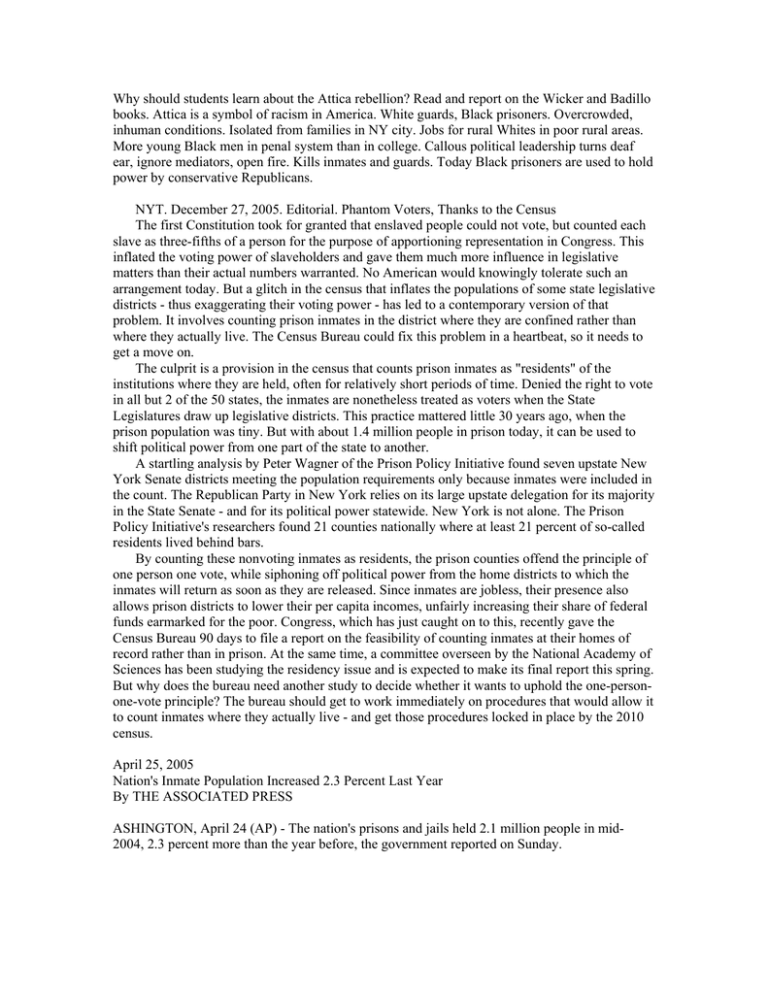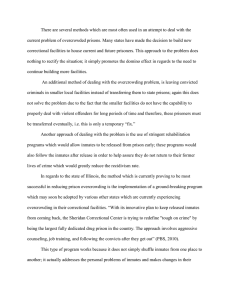Why should students learn about the Attica rebellion? Read and... books. Attica is a symbol of racism in America. White...
advertisement

Why should students learn about the Attica rebellion? Read and report on the Wicker and Badillo books. Attica is a symbol of racism in America. White guards, Black prisoners. Overcrowded, inhuman conditions. Isolated from families in NY city. Jobs for rural Whites in poor rural areas. More young Black men in penal system than in college. Callous political leadership turns deaf ear, ignore mediators, open fire. Kills inmates and guards. Today Black prisoners are used to hold power by conservative Republicans. NYT. December 27, 2005. Editorial. Phantom Voters, Thanks to the Census The first Constitution took for granted that enslaved people could not vote, but counted each slave as three-fifths of a person for the purpose of apportioning representation in Congress. This inflated the voting power of slaveholders and gave them much more influence in legislative matters than their actual numbers warranted. No American would knowingly tolerate such an arrangement today. But a glitch in the census that inflates the populations of some state legislative districts - thus exaggerating their voting power - has led to a contemporary version of that problem. It involves counting prison inmates in the district where they are confined rather than where they actually live. The Census Bureau could fix this problem in a heartbeat, so it needs to get a move on. The culprit is a provision in the census that counts prison inmates as "residents" of the institutions where they are held, often for relatively short periods of time. Denied the right to vote in all but 2 of the 50 states, the inmates are nonetheless treated as voters when the State Legislatures draw up legislative districts. This practice mattered little 30 years ago, when the prison population was tiny. But with about 1.4 million people in prison today, it can be used to shift political power from one part of the state to another. A startling analysis by Peter Wagner of the Prison Policy Initiative found seven upstate New York Senate districts meeting the population requirements only because inmates were included in the count. The Republican Party in New York relies on its large upstate delegation for its majority in the State Senate - and for its political power statewide. New York is not alone. The Prison Policy Initiative's researchers found 21 counties nationally where at least 21 percent of so-called residents lived behind bars. By counting these nonvoting inmates as residents, the prison counties offend the principle of one person one vote, while siphoning off political power from the home districts to which the inmates will return as soon as they are released. Since inmates are jobless, their presence also allows prison districts to lower their per capita incomes, unfairly increasing their share of federal funds earmarked for the poor. Congress, which has just caught on to this, recently gave the Census Bureau 90 days to file a report on the feasibility of counting inmates at their homes of record rather than in prison. At the same time, a committee overseen by the National Academy of Sciences has been studying the residency issue and is expected to make its final report this spring. But why does the bureau need another study to decide whether it wants to uphold the one-personone-vote principle? The bureau should get to work immediately on procedures that would allow it to count inmates where they actually live - and get those procedures locked in place by the 2010 census. April 25, 2005 Nation's Inmate Population Increased 2.3 Percent Last Year By THE ASSOCIATED PRESS ASHINGTON, April 24 (AP) - The nation's prisons and jails held 2.1 million people in mid2004, 2.3 percent more than the year before, the government reported on Sunday. The inmate population increased by slightly more than 48,000 from mid-2003 to mid-2004, a growth of about 900 inmates each week, according to the latest figures from the Bureau of Justice Statistics. The total inmate population has hovered around two million for the last few years: It was 2.1 million on June 30, 2002, and just below that mark a year later. While the crime rate has fallen over the last decade, the number of people going to prison and jail is outpacing the number of inmates released, said an author of the report, Paige M. Harrison. Ms. Harrison said the increase could be largely attributed to get-tough policies enacted in the 1980's and 1990's. Among them are mandatory sentences for drug crimes, "three strikes and you're out" laws for repeat offenders and "truth in sentencing" laws that restrict early releases. "As a whole, most of these policies remain in place," Ms. Harrison said. "These policies were a reaction to the rise in crime in the 80's and early 90's." Malcolm Young, executive director of the Sentencing Project, which promotes alternatives to prison, said, "We're working under the burden of laws and practices that have developed over 30 years that have focused on punishment and prison as our primary response to crime." Mr. Young said many of those incarcerated were not serious or violent offenders, but low-level drug offenders. He said ways to help lower that number included introducing drug treatment programs that offer effective ways of changing behavior and providing appropriate assistance for the mentally ill. The Justice Policy Institute, which advocates a more lenient system of punishment than incarceration, said the United States had the highest rate of incarceration in the world, followed by Britain, China, France, Japan and Nigeria. According to the government's report, there were 726 inmates for every 100,000 United States residents on June 30, 2004, compared with 716 a year earlier. Put another way, in 2004, one in every 138 residents was in prison or jail; the previous year it was one in every 140. In 2004, nearly 60 percent of prison and jail inmates were racial or ethnic minorities, the report said. An estimated 12.6 percent of all black men age 25 to 29 were in jails or prisons, compared with 3.6 percent of Hispanic men and 1.7 percent of white men in that age group, the report said. On June 30,2004, -- 2,131,180 prisoners were held in Federal or State prisons or in local jails -- an increase of 2.3% from midyear 2003, less than the average annual growth of 3.5% since yearend 1995. -- there were an estimated 486 prison inmates per 100,000 U.S. residents -- up from 411 at yearend 1995. -- the number of women under the jurisdiction of State or Federal prison authorities increased 2.9% from midyear 2003, reaching 103,310 and the number of men rose 2.0%, totaling 1,390,906. At midyear 2004 there were 4,919 black male prison and jail inmates per 100,000 black males in the United States, compared to 1,717 Hispanic male inmates per 100,000 Hispanic males and 717 white male inmates per 100,000 white males. Between 1995 and 2001, the increasing number of violent offenders accounted for 63% of the total growth of the State prison population; 15% of the total growth was attributable to the increasing number of drug offenders. Prison and Jail Inmates at Midyear 2004 Presents data on prison and jail inmates, collected from National Prisoner Statistics counts and the Annual Survey of Jails in 2004. This annual report provides for each State and the Federal system, the number of inmates and the overall incarceration rate per 100,000 residents. It offers trends since 1995 and percentage changes in prison populations since midyear and yearend 2003. The midyear report presents the number of prison inmates held in private facilities and the number of prisoners under 18 years of age held by State correctional authorities. It includes total numbers for prison and jail inmates by gender, race, and Hispanic origin as well as counts of jail inmates by conviction status and confinement status. The report also provides findings on rated capacity of local jails, percent of capacity occupied, and capacity added. Standard errors for jail estimates are only provided in the appendix tables of the electronic version of this report. Highlights include the following: At midyear 2004-* The Nation's prisons and jails incarcerated over 2.1 million persons. * In both jails and prisons, there were 123 female inmates per 100,000 women in the United States, compared to 1,348 male inmates per 100,000 men. * A total of 2,477 State prisoners were under age 18. * The number of inmates in custody in local jails rose by 22,689; in State prison by 15,375; and in Federal prison by 10,095.







